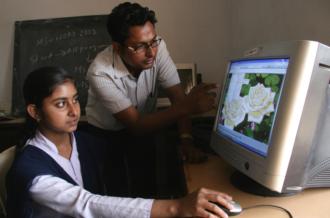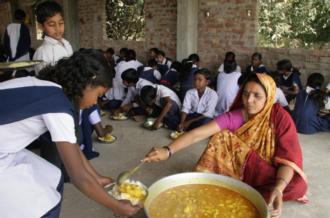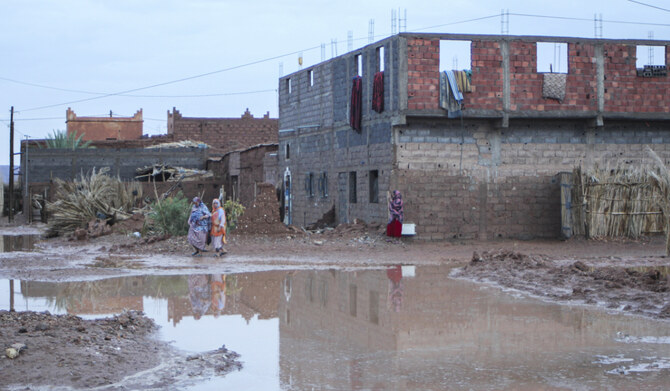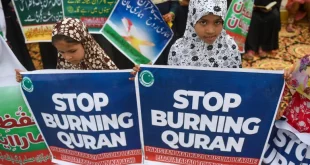Islamic seminaries with modern curriculum in eastern Indian state of West Bengal are helping to bridge religious divide.
|
Clad in white and blue salwar kameez (traditional Indian dress) and translating an Arabic verse from her Islamic studies textbook into Bengali, 15-year-old Puja Kshetrapal could pass for a Muslim. But she, along with almost half of the 200 tenth graders in Chatuspalli High Madrassa in Orgram village in India's West Bengal state, are Hindus. "Although it is called a madrassa (Islamic seminary), people in the area view it like a good regular school. So, my parents chose to send me to this institution," Puja told Al Jazeera.
Anwar Hossain, the headmaster of the Orgram madrassa located 125km north of the state capital, Kolkata, says that it is mostly its modern curriculum that has made the institution increasingly popular in the Hindu-majority society.
"Ordinary people believe that a madrassa is a place where students are taught only religious subjects, and that it has no connection with modern education," Hossain said. "For some years we have been working to change their notion. We are teaching our students all general subjects as their counterparts are studying in regular schools," he said. "After studying in our madrassa, children can plan their career in any field of their choice. This is the main reason why more than 60 percent of more than 1,400 students at the madrassa are non-Muslims now." Even, 11 of the 32 teachers in the madrassa are Hindu, Hossain added. Modern curriculum Madrassas are usually thought of as Muslim-only schools where children study only theology and end up as religious teachers or clerics. After 9/11, many in the non-Muslim world viewed South Asia's tens of thousands of madrassas with suspicion, regarding them as a breeding ground for radical strains of Islam. But in recent years, defying the stereotype, nearly 600 government-recognised madrassas in West Bengal have introduced a mainstream school curriculum, and non-Muslims are studying in almost all of them. Currently, about 15 percent of the students in the state's modernised madrassas are non-Muslims, and many of them are expecting to become engineers, doctors, scientists and other professionals.
Orgram and other madrassas in the state have undergone modernisation offering courses in physics, chemistry, biology, geography, mathematics, computer science, English language and literature and other regular subjects. Islamic studies and the Arabic language course form a small part of the curriculum. Funded by the state, the madrassas which are located mostly in rural Bengal charge no fees, and offer free school uniforms and mid-day meals, making them especially attractive to students from poor and lower middle-class families. Examples of Muslim students who attended the madrassas and are now successful in their careers have spurred many non-Muslim families to send their children to the madrassas, many say. "In Hindu-dominated society until some time back, madrassas – identified as Muslims only institutions – carried a stigma. Non-Muslims and even many Muslims used to stay away from them," Dr Khandkar Fariduddin, an eye surgeon and an alumnus of a modern madrassa told Al Jazeera. "But, now that they have known that a madrassa student can also become a doctor, engineer or other good professional, they are shedding their inhibitions and sending their children to these modern madrassas," he said. "Now the modern madrassas are part of mainstream education infrastructure in West Bengal." International accolades In 2006, the federal government-appointed Justice R Sachar Committee recommended in its report on Social, Economic and Educational Status of the Muslim Community in India that the madrassas in the country needed to be modernised in efforts to boost development in the backward community. In 2007, West Bengal became the first state to begin the modernisation of the traditional madrassas with support from the federal government as part of the Prime Minister's 15-Point Programme for Minorities. Two years later, the process of modernisation of the madrassas earned West Bengal international accolades.
The Brookings Doha Center, which is located in Qatar and is sponsored by the Brookings Institution of Washington, in 2009 identified Bengal's madrassas as models for modern education and suggested that Pakistan should emulate them. "Madrassas have a noble history of use in furthering the cause of science and learning in medieval Islam, but that tradition has been largely forgotten in Pakistan because of a relatively uneducated theological establishment taking over the administration of most madrassas," said the Brookings study, Pakistan's Madrassas: The Need for Internal Reform and the Role of International Assistance. The report noted that in West Bengal, "because of the higher quality of education at the madrassas, even non-Muslims were actively enrolling in them." Mohammad Fazle Rabbi, president of West Bengal Board of Madrassa Education, said that the modernisation of the madrassas had benefitted the society immensely and that the process would continue. "The modernisation of the madrassas was originally aimed to expose an increased number of Muslim children to modern education and to empower the backward community. But our madrassas have ended up helping Muslims as well as non-Muslims," Rabbi told Al Jazeera. "They are not viewed as Muslim-only institutions any more…rather are serving the society as a whole." Benefits community When the local government began introducing mainstream school curriculum in West Bengal in 2007, several Muslim leaders resisted the government action, terming it as an attack on the madrassas and Islam. But now several community leaders have come out in the open in support of the modernisation and other provinces like Maharashtra, Bihar and Kerala have also started revamping the curriculum of their traditional madrassas. "We cannot achieve anything substantial until the madrassa system is modernised following the latest trends in the education sector the world over. So, the ongoing modernisation of the madrassas is in the interest of our community," All India Muslim Women's Personal Law Board President, Shaista Amber, told Al Jazeera. "Muslims should actively support this process of reform of madrassa education."
Viewing the introduction of contemporary curriculum to the madrassas as "a fusion between the faith and modern systems of knowledge, especially of science", North Eastern Hill University professor and social activist Prasenjit Biswas said that along with others, the Muslim community is benefitting immensely from the "attractive educational and cultural innovation". "Madrassa students learning science would locate themselves at the borderlines of natural sciences and faith as a practice. The fusion results into something like opening of the mind towards newer developments and also turning an open and enlightened mind towards the sacred," Biswas said. "This would generate a balanced and refined personality who can negotiate between differences of approach and stand as a bridge between Islam and modernity." Bridging communal divide Non-Muslim students studying in these madrassas have a special opportunity to get an exposure to Islamic as well as the modern western knowledge systems, and it is creating a new positive orientation to their life by combining the best of both the worldviews, he said. "Madrassas based on strong intellectual traditions that draw from other cultures and religions can help overturn the historical divide between Hindus and Muslims, as easy access to Islamic tradition combined with other such traditions shall build up inter-cultural and inter-religious bridges," Biswas said. Agreeing to the view of Biswas, Prince Haldar, a 12th grade Hindu student at Orgram madrassa, said that his madrassa education had helped him better understand Islam and had brought him closer to Muslims. "Before I came to study in this madrassa, I was told that Islam was a militant religion and Muslims could not be friends of Hindus. I also heard that Muslims were biased against other religions," Prince told Al Jazeera. "But now after studying in this madrassa for five years I have found that people have many incorrect beliefs about Islam and Muslims." |
|||||
|
Source:
Al Jazeera
|
|||||
Post Disclaimer | Support Us
Support Us
The sailanmuslim.com web site entirely supported by individual donors and well wishers. If you regularly visit this site and wish to show your appreciation, or if you wish to see further development of sailanmuslim.com, please donate us
IMPORTANT : All content hosted on sailanmuslim.com is solely for non-commercial purposes and with the permission of original copyright holders. Any other use of the hosted content, such as for financial gain, requires express approval from the copyright owners.
 Sri lanka Muslims Web Portal Sri Lanka Muslims News Center
Sri lanka Muslims Web Portal Sri Lanka Muslims News Center






